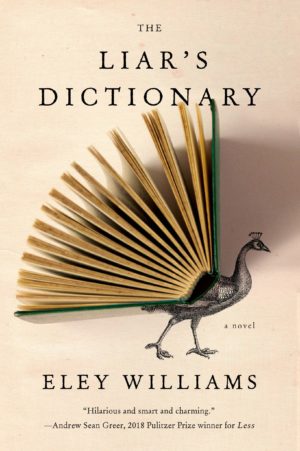The Liar’s Dictionary
by Eley Williams
reviewed by Olive Fellows
Dictionaries tend to be utilitarian, unglamorous things—pulled off of a shelf when needed, but otherwise gathering dust, especially as readers turn to digital resources. But in the preface of her debut novel, The Liar’s Dictionary, Eley Williams shrugs off that drab image, inviting readers through her spry language to imagine their own perfect dictionary and all the tangibles and intangibles it would possess. The structure of the book even mimics a dictionary, with a chapter for every letter of the alphabet, beginning with “A” for “artful” and “Z” for the tongue-twisting “zugzwang.”
This invitation to see dictionaries as playgrounds and words as chewing gum sets a jovial yet cerebral tone that suits the stories of the two main characters, doubles living a century apart. In the modern day, Mallory is an intern at the struggling Swansby House, publisher of an encyclopedic dictionary known not for prestige, but, as one character notes, “for not being finished. Having mistakes and being a bit eccentric.” As it turns out, the dictionary contains even more errors than the public may realize. During the digitization process, the head of Swansby discovers, to his horror, that there are an unknown number of fake entries—or mountweazels, normally intended to catch plagiarists in the act—that are not supposed to be there. It’s Mallory’s job to weed out these bogus words.
She doesn’t know which former employee is the culprit, but we do. Peter Winceworth worked for Swansby House back in 1899, and we meet him shortly before he gets the idea to make up words for the dictionary—or rather, just before he’s reached his breaking point. Winceworth isn’t popular in the office; he’s largely ignored and when he is heard, he’s teased for his lisp, especially as his work for the dictionary strands him in the “S” section. Readers might feel bad for him if he didn’t admit that his lisp, like his made-up words, isn’t real.
Not even Winceworth himself knows why he affects the lisp, though he suspects it’s out of laziness. As we get to know him, however, it seems likely he’s hiding behind it. Winceworth is a sensitive man, prickling at the slightest hint of mockery at his expense; perhaps he wants to deflect deeper attacks, or uses the lisp as an excuse not to open up.
Winceworth and Mallory have a lot more in common than an employer. Mallory, too, is not entirely comfortable sharing who she is with the world, but this is because she’s still figuring out who she is. When she starts working at Swansby’s, “one of the first words I looked up,” Mallory tells us, is “queer.” She may live with her girlfriend, but Mallory doesn’t feel comfortable discussing her sexuality or making it known. For two people who work with words all day long, Peter and Mallory leave a great many things unsaid.
Solidifying the idea that these are two characters caged and held back from expressing themselves is a substantial amount of avian imagery. This is hinted at by the American cover, which shows a peacock fanning out book pages in place of colorful plumage. At one point in Liar’s Dictionary, a choking pelican is saved by an emergency surgery with a pen instead of a scalpel. An introductory scene, during which Mallory is sitting in the aptly named Swansby’s offices, shows her unable to immediately respond to her boss, as she’s busy chewing an entire hard-boiled egg. Mallory’s girlfriend Pip also has a bird-inspired name, the two discover while turning the detective slog through the dictionary into their private jaunt: pip means “to crack (most likely the shell of the egg) when hatching.”
For both Winceworth and Mallory, love is a motivating force to break free of the constraints, real or imaginary, holding them back. But after seeing them bottled up for so long, readers can expect some explosive moments in each storyline before Mallory and Peter can truly move forward.
The inclusion of a blurb from Andrew Sean Greer on the American cover of The Liar’s Dictionary was apropos: the debut is highly reminiscent of Greer’s Pulitzer Prize–winning Less in its focus on character development and its insistence on a fun reading experience. Williams’s first novel may be guilty of being wordy, but for word nerds, the label might as well be a badge of honor. Williams seems to be speaking through Mallory when she writes, “simply put is impossible, and not the way for me.” The Liar’s Dictionary is a terrific reminder of just how fun words can be, and how powerful they become in showing the world—and reminding ourselves—precisely who we are.
Published on May 3, 2021

